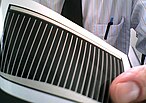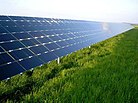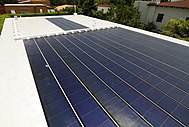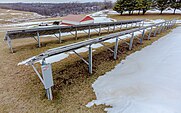Solar panel

A solar panel is a device that converts sunlight into electricity by using photovoltaic (PV) cells. PV cells are made of materials that produce excited electrons when exposed to light. The electrons flow through a circuit and produce direct current (DC) electricity, which can be used to power various devices or be stored in batteries. Solar panels are also known as solar cell panels, solar electric panels, or PV modules.
Solar panels are usually arranged in groups called arrays or systems. A photovoltaic system consists of one or more solar panels, an inverter that converts DC electricity to alternating current (AC) electricity, and sometimes other components such as controllers, meters, and trackers. Most panels are in solar farms or rooftop solar panels which supply the electricity grid
Some advantages of solar panels are that they use a renewable and clean source of energy, reduce greenhouse gas emissions, and lower electricity bills. Some disadvantages are that they depend on the availability and intensity of sunlight, require cleaning, and have high initial costs. Solar panels are widely used for residential, commercial, and industrial purposes, as well as in space, often together with batteries.
History
[edit]In 1839, the ability of some materials to create an electrical charge from light exposure was first observed by the French physicist Edmond Becquerel.[1] Though these initial solar panels were too inefficient for even simple electric devices, they were used as an instrument to measure light.[2]
The observation by Becquerel was not replicated again until 1873, when the English electrical engineer Willoughby Smith discovered that the charge could be caused by light hitting selenium. After this discovery, William Grylls Adams and Richard Evans Day published "The action of light on selenium" in 1876, describing the experiment they used to replicate Smith's results.[1][3]
In 1881, the American inventor Charles Fritts created the first commercial solar panel, which was reported by Fritts as "continuous, constant and of considerable force not only by exposure to sunlight but also to dim, diffused daylight".[4] However, these solar panels were very inefficient, especially compared to coal-fired power plants.
In 1939, Russell Ohl created the solar cell design that is used in many modern solar panels. He patented his design in 1941.[5] In 1954, this design was first used by Bell Labs to create the first commercially viable silicon solar cell.[1]
Solar panel installers saw significant growth between 2008 and 2013.[6] Due to that growth many installers had projects that were not "ideal" solar roof tops to work with and had to find solutions to shaded roofs and orientation difficulties.[7] This challenge was initially addressed by the re-popularization of micro-inverters and later the invention of power optimizers.
Solar panel manufacturers partnered with micro-inverter companies to create AC modules and power optimizer companies partnered with module manufacturers to create smart modules.[8] In 2013 many solar panel manufacturers announced and began shipping their smart module solutions.[9]
Theory and construction
[edit]
Photovoltaic modules consist of a large number of solar cells and use light energy (photons) from the Sun to generate electricity through the photovoltaic effect. Most modules use wafer-based crystalline silicon cells or thin-film cells. The structural (load carrying) member of a module can be either the top layer or the back layer. Cells must be protected from mechanical damage and moisture. Most modules are rigid, but semi-flexible ones based on thin-film cells are also available. The cells are usually connected electrically in series, one to another to the desired voltage, and then in parallel to increase current. The power (in watts) of the module is the voltage (in volts) multiplied by the current (in amperes), and depends both on the amount of light and on the electrical load connected to the module. The manufacturing specifications on solar panels are obtained under standard conditions, which are usually not the true operating conditions the solar panels are exposed to on the installation site.[10]
A PV junction box is attached to the back of the solar panel and functions as its output interface. External connections for most photovoltaic modules use MC4 connectors to facilitate easy weatherproof connections to the rest of the system. A USB power interface can also be used.[11] Solar panels also use metal frames consisting of racking components, brackets, reflector shapes, and troughs to better support the panel structure.[citation needed]
Cell connection techniques
[edit]Solar modular cells need to be connected together to form the module, with front electrodes blocking the solar cell front optical surface area slightly. To maximize frontal surface area available for sunlight and improve solar cell efficiency, manufacturers use varying rear electrode solar cell connection techniques:
- Passivated emitter rear contact (PERC) adds a polymer film to capture light
- Tunnel oxide passivated contact (TOPCon) adds an oxidation layer to the PERC film to capture more light[12]
- Interdigitated back contact (IBC)[13]
Arrays of PV modules
[edit]A single solar module can produce only a limited amount of power; most installations contain multiple modules adding their voltages or currents. A photovoltaic system typically includes an array of photovoltaic modules, an inverter, a battery pack for energy storage, a charge controller, interconnection wiring, circuit breakers, fuses, disconnect switches, voltage meters, and optionally a solar tracking mechanism. Equipment is carefully selected to optimize energy output and storage, reduce power transmission losses, and convert from direct current to alternating current.
Smart solar modules
[edit]
Smart modules are different from traditional solar panels because the power electronics embedded in the module offers enhanced functionality such as panel-level maximum power point tracking, monitoring, and enhanced safety.[citation needed] Power electronics attached to the frame of a solar module, or connected to the photovoltaic circuit through a connector, are not properly considered smart modules.[14]
Several companies have begun incorporating into each PV module various embedded power electronics such as:
- Maximum power point tracking (MPPT) power optimizers, a DC-to-DC converter technology developed to maximize the power harvest from solar photovoltaic systems by compensating for shading effects, wherein a shadow falling on a section of a module causes the electrical output of one or more strings of cells in the module to fall to near zero, but not having the output of the entire module fall to zero.[15]
- Solar performance monitors for data and fault detection
Technology
[edit]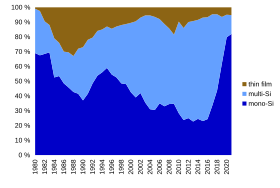
Most solar modules are currently produced from crystalline silicon (c-Si) solar cells made of polycrystalline or monocrystalline silicon. In 2021, crystalline silicon accounted for 95% of worldwide PV production,[16][17] while the rest of the overall market is made up of thin-film technologies using cadmium telluride (CdTe), copper indium gallium selenide (CIGS) and amorphous silicon (a-Si).[18]
Emerging, third-generation solar technologies use advanced thin-film cells. They produce a relatively high-efficiency conversion for a lower cost compared with other solar technologies. Also, high-cost, high-efficiency, and close-packed rectangular multi-junction (MJ) cells are usually used in solar panels on spacecraft, as they offer the highest ratio of generated power per kilogram lifted into space. MJ-cells are compound semiconductors and made of gallium arsenide (GaAs) and other semiconductor materials. Another emerging PV technology using MJ-cells is concentrator photovoltaics (CPV).
Thin film
[edit]- Top: thin-film silicon laminates being installed onto a roof.
- Middle: CIGS solar cell on a flexible plastic backing and rigid CdTe panels mounted on a supporting structure
- Bottom: thin-film laminates on rooftops
Thin-film solar cells are a type of solar cell made by depositing one or more thin layers (thin films or TFs) of photovoltaic material onto a substrate, such as glass, plastic or metal. Thin-film solar cells are typically a few nanometers (nm) to a few microns (μm) thick–much thinner than the wafers used in conventional crystalline silicon (c-Si) based solar cells, which can be up to 200 μm thick. Thin-film solar cells are commercially used in several technologies, including cadmium telluride (CdTe), copper indium gallium diselenide (CIGS), and amorphous thin-film silicon (a-Si, TF-Si).
Solar cells are often classified into so-called generations based on the active (sunlight-absorbing) layers used to produce them, with the most well-established or first-generation solar cells being made of single- or multi-crystalline silicon. This is the dominant technology currently used in most solar PV systems. Most thin-film solar cells are classified as second generation, made using thin layers of well-studied materials like amorphous silicon (a-Si), cadmium telluride (CdTe), copper indium gallium selenide (CIGS), or gallium arsenide (GaAs). Solar cells made with newer, less established materials are classified as third-generation or emerging solar cells. This includes some innovative thin-film technologies, such as perovskite, dye-sensitized, quantum dot, organic, and CZTS thin-film solar cells.
Thin-film cells have several advantages over first-generation silicon solar cells, including being lighter and more flexible due to their thin construction. This makes them suitable for use in building-integrated photovoltaics and as semi-transparent, photovoltaic glazing material that can be laminated onto windows. Other commercial applications use rigid thin film solar panels (interleaved between two panes of glass) in some of the world's largest photovoltaic power stations. Additionally, the materials used in thin-film solar cells are typically produced using simple and scalable methods more cost-effective than first-generation cells, leading to lower environmental impacts like greenhouse gas (GHG) emissions in many cases. Thin-film cells also typically outperform renewable and non-renewable sources for electricity generation in terms of human toxicity and heavy-metal emissions.
Despite initial challenges with efficient light conversion, especially among third-generation PV materials, as of 2023 some thin-film solar cells have reached efficiencies of up to 29.1% for single-junction thin-film GaAs cells, exceeding the maximum of 26.1% efficiency for standard single-junction first-generation solar cells. Multi-junction concentrator cells incorporating thin-film technologies have reached efficiencies of up to 47.6% as of 2023.[19]
Still, many thin-film technologies have been found to have shorter operational lifetimes and larger degradation rates than first-generation cells in accelerated life testing, which has contributed to their somewhat limited deployment. Globally, the PV marketshare of thin-film technologies remains around 5% as of 2023.[20] However, thin-film technology has become considerably more popular in the United States, where CdTe cells alone accounted for nearly 30% of new utility-scale deployment in 2022.[21]Mounting and tracking
[edit]
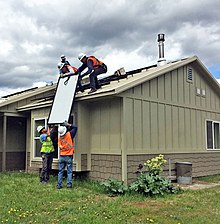
Ground
[edit]Large utility-scale solar power plants frequently use ground-mounted photovoltaic systems. Their solar modules are held in place by racks or frames that are attached to ground-based mounting supports.[22][23] Ground based mounting supports include:
- Pole mounts, which are driven directly into the ground or embedded in concrete.
- Foundation mounts, such as concrete slabs or poured footings
- Ballasted footing mounts, such as concrete or steel bases that use weight to secure the solar module system in position and do not require ground penetration. This type of mounting system is well suited for sites where excavation is not possible such as capped landfills and simplifies decommissioning or relocation of solar module systems.
Vertical bifacial solar array
[edit]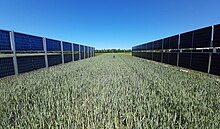

Vertical bifacial solar cells are oriented towards east and west to catch the sun's irradiance more efficiently in the morning and evening. Applications include agrivoltaics, solar fencing, highway and railroad noise dampeners and barricades.[24]
Roof
[edit]Roof-mounted solar power systems consist of solar modules held in place by racks or frames attached to roof-based mounting supports.[25] Roof-based mounting supports include:
- Rail mounts, which are attached directly to the roof structure and may use additional rails for attaching the module racking or frames.
- Ballasted footing mounts, such as concrete or steel bases that use weight to secure the panel system in position and do not require through penetration. This mounting method allows for decommissioning or relocation of solar panel systems with no adverse effect on the roof structure.
- All wiring connecting adjacent solar modules to the energy harvesting equipment must be installed according to local electrical codes and should be run in a conduit appropriate for the climate conditions
Solar Canopy
[edit]
Solar canopies are solar arrays which are installed on top of a traditional canopy. These canopies could be a parking lot canopy, carport, gazebo, Pergola, or patio cover.
There are many benefits, which include maximizing the space available in urban areas while also providing shade for cars. The energy produced can be used to create electric vehicle (EV) charging stations.[26]
Portable
[edit]Portable solar panels can ensure electric current, enough to charge devices (mobile, radio, ...) via USB-port or to charge a powerbank f.e.
Special features of the panels include high flexibility, high durability & waterproof characteristics. They are good for travel or camping.

Tracking
[edit]Solar trackers increase the energy produced per module at the cost of mechanical complexity and increased need for maintenance. They sense the direction of the Sun and tilt or rotate the modules as needed for maximum exposure to the light.[27][28]
Alternatively, fixed racks can hold modules stationary throughout the day at a given tilt (zenith angle) and facing a given direction (azimuth angle). Tilt angles equivalent to an installation's latitude are common. Some systems may also adjust the tilt angle based on the time of year.[29]
On the other hand, east- and west-facing arrays (covering an east–west facing roof, for example) are commonly deployed. Even though such installations will not produce the maximum possible average power from the individual solar panels, the cost of the panels is now usually cheaper than the tracking mechanism and they can provide more economically valuable power during morning and evening peak demands than north or south facing systems.[30]
Concentrator
[edit]Some special solar PV modules include concentrators in which light is focused by lenses or mirrors onto smaller cells. This enables the cost-effective use of highly efficient, but expensive cells (such as gallium arsenide) with the trade-off of using a higher solar exposure area.[citation needed] Concentrating the sunlight can also raise the efficiency to around 45%.[31]
Light capture
[edit]The amount of light absorbed by a solar cell depends on the angle of incidence of whatever direct sunlight hits it. This is partly because the amount falling on the panel is proportional to the cosine of the angle of incidence, and partly because at high angle of incidence more light is reflected. To maximize total energy output, modules are often oriented to face south (in the Northern Hemisphere) or north (in the Southern Hemisphere) and tilted to allow for the latitude. Solar tracking can be used to keep the angle of incidence small.
Solar panels are often coated with an anti-reflective coating, which is one or more thin layers of substances with refractive indices intermediate between that of silicon and that of air. This causes destructive interference in the reflected light, diminishing the amount. Photovoltaic manufacturers have been working to decrease reflectance with improved anti-reflective coatings or with textured glass.[32][33]
Power curve
[edit]
In general with individual solar panels, if not enough current is taken, then power isn't maximised. If too much current is taken then the voltage collapses. The optimum current draw is roughly proportional to the amount of sunlight striking the panel. Solar panel capacity is specified by the MPP (maximum power point) value of solar panels in full sunlight.
Inverters
[edit]Solar inverters convert the DC power provided by panels to AC power.
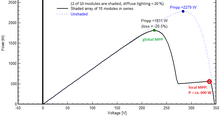
MPP (Maximum power point) of the solar panel consists of MPP voltage (Vmpp) and MPP current (Impp). Performing maximum power point tracking (MPPT), a solar inverter samples the output (I-V curve) from the solar cell and applies the proper electrical load to obtain maximum power.
An AC (alternating current) solar panel has a small DC to AC microinverter on the back and produces AC power with no external DC connector. AC modules are defined by Underwriters Laboratories as the smallest and most complete system for harvesting solar energy.[34][need quotation to verify]
Micro-inverters work independently to enable each panel to contribute its maximum possible output for a given amount of sunlight, but can be more expensive.[35]
Module interconnection
[edit]
Module electrical connections are made with conducting wires that take the current off the modules and are sized according to the current rating and fault conditions, and sometimes include in-line fuses.
Panels are typically connected in series of one or more panels to form strings to achieve a desired output voltage, and strings can be connected in parallel to provide the desired current capability (amperes) of the PV system.
In string connections the voltages of the modules add, but the current is determined by the lowest performing panel. This is known as the "Christmas light effect". In parallel connections the voltages will be the same, but the currents add. Arrays are connected up to meet the voltage requirements of the inverters and to not greatly exceed the current limits.
Blocking and bypass diodes may be incorporated within the module or used externally to deal with partial array shading, in order to maximize output. For series connections, bypass diodes are placed in parallel with modules to allow current to bypass shaded modules which would otherwise severely limit the current. For paralleled connections, a blocking diode may be placed in series with each module's string to prevent current flowing backwards through shaded strings thus short-circuiting other strings.
Connectors
[edit]Outdoor solar panels usually include MC4 connectors, automotive solar panels may include an auxiliary power outlet and/or USB adapter and indoor panels may have a microinverter.
Efficiency
[edit]
Each module is rated by its DC output power under standard test conditions (STC) and hence the on field output power might vary. Power typically ranges from 100 to 365 Watts (W). The efficiency of a module determines the area of a module given the same rated output – an 8% efficient 230 W module will have twice the area of a 16% efficient 230 W module. Some commercially available solar modules exceed 24% efficiency.[37][38] Currently,[needs update] the best achieved sunlight conversion rate (solar module efficiency) is around 21.5% in new commercial products[39] typically lower than the efficiencies of their cells in isolation. The most efficient mass-produced solar modules have power density values of up to 175 W/m2 (16.22 W/ft2).[40]
The current versus voltage curve of a module provides useful information about its electrical performance.[41] Manufacturing processes often cause differences in the electrical parameters of different modules photovoltaic, even in cells of the same type. Therefore, only the experimental measurement of the I–V curve allows us to accurately establish the electrical parameters of a photovoltaic device. This measurement provides highly relevant information for the design, installation and maintenance of photovoltaic systems. Generally, the electrical parameters of photovoltaic modules are measured by indoor tests. However, outdoor testing has important advantages such as no expensive artificial light source required, no sample size limitation, and more homogeneous sample illumination.
Capacity factor of solar panels is limited primarily by geographic latitude and varies significantly depending on cloud cover, dust, day length and other factors. In the United Kingdom, seasonal capacity factor ranges from 2% (December) to 20% (July), with average annual capacity factor of 10–11%, while in Spain the value reaches 18%.[42] Globally, capacity factor for utility-scale PV farms was 16.1% in 2019.[43][unreliable source?]
Overheating is the most important factor for the efficiency of the solar panel.[44]
Radiation-dependent efficiency
[edit]Depending on construction, photovoltaic modules can produce electricity from a range of frequencies of light, but usually cannot cover the entire solar radiation range (specifically, ultraviolet, infrared and low or diffused light). Hence, much of the incident sunlight energy is wasted by solar modules, and they can give far higher efficiencies if illuminated with monochromatic light. Therefore, another design concept is to split the light into six to eight different wavelength ranges that will produce a different color of light, and direct the beams onto different cells tuned to those ranges.[45]
Performance and degradation
[edit]

Module performance is generally rated under standard test conditions (STC): irradiance of 1,000 W/m2, solar spectrum of AM 1.5 and module temperature at 25 °C.[46] The actual voltage and current output of the module changes as lighting, temperature and load conditions change, so there is never one specific voltage at which the module operates. Performance varies depending on geographic location, time of day, the day of the year, amount of solar irradiance, direction and tilt of modules, cloud cover, shading, soiling, state of charge, and temperature. Performance of a module or panel can be measured at different time intervals with a DC clamp meter or shunt and logged, graphed, or charted with a chart recorder or data logger.
For optimum performance, a solar panel needs to be made of similar modules oriented in the same direction perpendicular to direct sunlight. Bypass diodes are used to circumvent broken or shaded panels and optimize output. These bypass diodes are usually placed along groups of solar cells to create a continuous flow.[47]
Electrical characteristics include nominal power (PMAX, measured in W), open-circuit voltage (VOC), short-circuit current (ISC, measured in amperes), maximum power voltage (VMPP), maximum power current (IMPP), peak power, (watt-peak, Wp), and module efficiency (%).
Open-circuit voltage or VOC is the maximum voltage the module can produce when not connected to an electrical circuit or system.[48] VOC can be measured with a voltmeter directly on an illuminated module's terminals or on its disconnected cable.
The peak power rating, Wp, is the maximum output under standard test conditions (not the maximum possible output). Typical modules, which could measure approximately 1 by 2 metres (3 ft × 7 ft), will be rated from as low as 75 W to as high as 600 W, depending on their efficiency. At the time of testing, the test modules are binned according to their test results, and a typical manufacturer might rate their modules in 5 W increments, and either rate them at +/- 3%, +/-5%, +3/-0% or +5/-0%.[49][50][51]
Influence of temperature
[edit]The performance of a photovoltaic (PV) module depends on the environmental conditions, mainly on the global incident irradiance G in the plane of the module. However, the temperature T of the p–n junction also influences the main electrical parameters: the short circuit current ISC, the open circuit voltage VOC and the maximum power Pmax. In general, it is known that VOC shows a significant inverse correlation with T, while for ISC this correlation is direct, but weaker, so that this increase does not compensate for the decrease in VOC. As a consequence, Pmax decreases when T increases. This correlation between the power output of a solar cell and the working temperature of its junction depends on the semiconductor material, and is due to the influence of T on the concentration, lifetime, and mobility of the intrinsic carriers, i.e., electrons and gaps. inside the photovoltaic cell.
Temperature sensitivity is usually described by temperature coefficients, each of which expresses the derivative of the parameter to which it refers with respect to the junction temperature. The values of these parameters can be found in any data sheet of the photovoltaic module; are the following:
- β: VOC variation coefficient with respect to T, given by ∂VOC/∂T.
- α: Coefficient of variation of ISC with respect to T, given by ∂ISC/∂T.
- δ: Coefficient of variation of Pmax with respect to T, given by ∂Pmax/∂T.
Techniques for estimating these coefficients from experimental data can be found in the literature[52]
Degradation
[edit]The ability of solar modules to withstand damage by rain, hail, heavy snow load, and cycles of heat and cold varies by manufacturer, although most solar panels on the U.S. market are UL listed, meaning they have gone through testing to withstand hail.[53]
Potential-induced degradation (also called PID) is a potential-induced performance degradation in crystalline photovoltaic modules, caused by so-called stray currents.[54] This effect may cause power loss of up to 30%.[55]
Advancements in photovoltaic technologies have brought about the process of "doping" the silicon substrate to lower the activation energy thereby making the panel more efficient in converting photons to retrievable electrons.[56]
Chemicals such as boron (p-type) are applied into the semiconductor crystal in order to create donor and acceptor energy levels substantially closer to the valence and conductor bands.[57] In doing so, the addition of boron impurity allows the activation energy to decrease twenty-fold from 1.12 eV to 0.05 eV. Since the potential difference (EB) is so low, the boron is able to thermally ionize at room temperatures. This allows for free energy carriers in the conduction and valence bands thereby allowing greater conversion of photons to electrons.
The power output of a photovoltaic (PV) device decreases over time. This decrease is due to its exposure to solar radiation as well as other external conditions. The degradation index, which is defined as the annual percentage of output power loss, is a key factor in determining the long-term production of a photovoltaic plant. To estimate this degradation, the percentage of decrease associated with each of the electrical parameters. The individual degradation of a photovoltaic module can significantly influence the performance of a complete string. Furthermore, not all modules in the same installation decrease their performance at exactly the same rate. Given a set of modules exposed to long-term outdoor conditions, the individual degradation of the main electrical parameters and the increase in their dispersion must be considered. As each module tends to degrade differently, the behavior of the modules will be increasingly different over time, negatively affecting the overall performance of the plant.[citation needed]
There are several studies dealing with the power degradation analysis of modules based on different photovoltaic technologies available in the literature. According to a recent study,[58] the degradation of crystalline silicon modules is very regular, oscillating between 0.8% and 1.0% per year.
On the other hand, if we analyze the performance of thin-film photovoltaic modules, an initial period of strong degradation is observed (which can last several months and even up to 2 years), followed by a later stage in which the degradation stabilizes, being then comparable to that of crystalline silicon.[59] Strong seasonal variations are also observed in such thin-film technologies because the influence of the solar spectrum is much greater. For example, for modules of amorphous silicon, micromorphic silicon or cadmium telluride, we are talking about annual degradation rates for the first years of between 3% and 4%.[60] However, other technologies, such as CIGS, show much lower degradation rates, even in those early years.
Maintenance
[edit]

Solar panel conversion efficiency, typically in the 20% range, is reduced by the accumulation of dust, grime, pollen, and other particulates on the solar panels, collectively referred to as soiling. "A dirty solar panel can reduce its power capabilities by up to 30% in high dust/pollen or desert areas", says Seamus Curran, associate professor of physics at the University of Houston and director of the Institute for NanoEnergy, which specializes in the design, engineering, and assembly of nanostructures.[61] The average soiling loss in the world in 2018 is estimated to be at least 3% – 4%.[62]
Paying to have solar panels cleaned is a good investment in many regions, as of 2019.[62] However, in some regions, cleaning is not cost-effective. In California as of 2013 soiling-induced financial losses were rarely enough to warrant the cost of washing the panels. On average, panels in California lost a little less than 0.05% of their overall efficiency per day.[63]
There are also occupational hazards with solar panel installation and maintenance. A 2015–2018 study in the UK investigated 80 PV-related incidents of fire, with over 20 "serious fires" directly caused by PV installation, including 37 domestic buildings and 6 solar farms. In 1⁄3 of the incidents a root cause was not established and in a majority of others was caused by poor installation, faulty product or design issues. The most frequent single element causing fires was the DC isolators.[64]
A 2021 study by kWh Analytics determined median annual degradation of PV systems at 1.09% for residential and 0.8% for non-residential ones, almost twice that previously assumed.[65] A 2021 module reliability study found an increasing trend in solar module failure rates with 30% of manufacturers experiencing safety failures related to junction boxes (growth from 20%) and 26% bill-of-materials failures (growth from 20%).[66]
Cleaning methods for solar panels can be divided into 5 groups: manual tools, mechanized tools (such as tractor mounted brushes), installed hydraulic systems (such as sprinklers), installed robotic systems, and deployable robots. Manual cleaning tools are by far the most prevalent method of cleaning, most likely because of the low purchase cost. However, in a Saudi Arabian study done in 2014, it was found that "installed robotic systems, mechanized systems, and installed hydraulic systems are likely the three most promising technologies for use in cleaning solar panels".[67]
Waste and recycling
[edit]There were 30 thousand tonnes of PV waste in 2021, and the annual amount was estimated by Bloomberg NEF to rise to more than 1 million tons by 2035 and more than 10 million by 2050.[68] For comparison, 750 million tons of fly ash waste was produced by coal power in 2022.[69] In the United States, around 90% of decommissioned solar panels end up in landfills as of 2023.[70] Most parts of a solar module can be recycled including up to 95% of certain semiconductor materials or the glass as well as large amounts of ferrous and non-ferrous metals.[71] Some private companies and non-profit organizations take-back and recycle end-of-life modules.[72] EU law requires manufacturers to ensure their solar panels are recycled properly. Similar legislation is underway in Japan, India, and Australia.[73] A 2023 Australian report said that there is a market for quality used panels and made recommendations for increasing reuse.[74]: 33
Recycling possibilities depend on the kind of technology used in the modules:
- Silicon based modules: aluminum frames and junction boxes are dismantled manually at the beginning of the process. The module is then crushed in a mill and the different fractions are separated – glass, plastics and metals.[75] It is possible to recover more than 80% of the incoming weight.[76] This process can be performed by flat glass recyclers, since the shape and composition of a PV module is similar to flat glass used in the building and automotive industry. The recovered glass, for example, is readily accepted by the glass foam and glass insulation industry.
- Non-silicon based modules: they require specific recycling technologies such as the use of chemical baths in order to separate the different semiconductor materials.[77] For cadmium telluride modules, the recycling process begins by crushing the module and subsequently separating the different fractions. This recycling process is designed to recover up to 90% of the glass and 95% of the semiconductor materials contained.[78] Some commercial-scale recycling facilities have been created in recent years by private companies.[79]
Since 2010, there is an annual European conference bringing together manufacturers, recyclers and researchers to look at the future of PV module recycling.[80][81]
Production
[edit]| Module producer | Shipments in 2019 (GW)[82] |
|---|---|
| Jinko Solar | 14.2 |
| JA Solar | 10.3 |
| Trina Solar | 9.7 |
| LONGi Solar | 9.0 |
| Canadian Solar | 8.5 |
| Hanwha Q Cells | 7.3 |
| Risen Energy | 7.0 |
| First Solar | 5.5 |
| GCL System | 4.8 |
| Shunfeng Photovoltaic | 4.0 |
The production of PV systems has followed a classic learning curve effect, with significant cost reduction occurring alongside large rises in efficiency and production output.[83]
With over 100% year-on-year growth in PV system installation, PV module makers dramatically increased their shipments of solar modules in 2019. They actively expanded their capacity and turned themselves into gigawatt GW players.[84] According to Pulse Solar, five of the top ten PV module companies in 2019 have experienced a rise in solar panel production by at least 25% compared to 2019.[85]
The basis of producing most solar panels is mostly on the use of silicon cells. These silicon cells are typically 10–20% efficient[86] at converting sunlight into electricity, with newer production models exceeding 22%.[87]
In 2018, the world's top five solar module producers in terms of shipped capacity during the calendar year of 2018 were Jinko Solar, JA Solar, Trina Solar, Longi solar, and Canadian Solar.[88]
Price
[edit]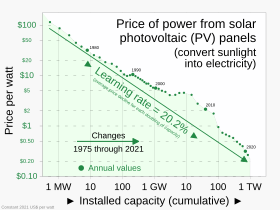
The price of solar electrical power has continued to fall so that in many countries it has become cheaper than fossil fuel electricity from the electricity grid since 2012, a phenomenon known as grid parity.[91] With the rise of global awareness, institutions such as the IRS have adopted a tax credit format, refunding a portion of any solar panel array for private use.[92] The price of a solar array only continues to fall.
Average pricing information divides in three pricing categories: those buying small quantities (modules of all sizes in the kilowatt range annually), mid-range buyers (typically up to 10 MWp annually), and large quantity buyers (self-explanatory—and with access to the lowest prices). Over the long term there is clearly a systematic reduction in the price of cells and modules. For example, in 2012 it was estimated that the quantity cost per watt was about US$0.60, which was 250 times lower than the cost in 1970 of US$150.[93][94] A 2015 study shows price/kWh dropping by 10% per year since 1980, and predicts that solar could contribute 20% of total electricity consumption by 2030, whereas the International Energy Agency predicts 16% by 2050.[95]
Real-world energy production costs depend a great deal on local weather conditions. In a cloudy country such as the United Kingdom, the cost per produced kWh is higher than in sunnier countries like Spain.


Following to RMI, Balance-of-System (BoS) elements, this is, non-module cost of non-microinverter solar modules (as wiring, converters, racking systems and various components) make up about half of the total costs of installations.
For merchant solar power stations, where the electricity is being sold into the electricity transmission network, the cost of solar energy will need to match the wholesale electricity price. This point is sometimes called 'wholesale grid parity' or 'busbar parity'.[91]
Standards
[edit]Standards generally used in photovoltaic modules:
- IEC 61215 (crystalline silicon performance), 61646 (thin film performance) and 61730 (all modules, safety), 61853 (Photovoltaic module performance testing & energy rating)
- ISO 9488 Solar energy—Vocabulary.
- UL 1703 from Underwriters Laboratories
- UL 1741 from Underwriters Laboratories
- UL 2703 from Underwriters Laboratories
- CE mark
- Electrical Safety Tester (EST) Series (EST-460, EST-22V, EST-22H, EST-110).
Applications
[edit]There are many practical applications for the use of solar panels or photovoltaics. It can first be used in agriculture as a power source for irrigation. In health care solar panels can be used to refrigerate medical supplies. It can also be used for infrastructure. PV modules are used in photovoltaic systems and include a large variety of electric devices:
- Agrivoltaics
- Solar canals
- Photovoltaic power stations
- Rooftop solar PV systems
- Standalone PV systems
- Solar hybrid power systems
- Concentrated photovoltaics
- Floating solar; water-borne solar panels
- Solar planes
- Solar-powered water purification
- Solar-pumped lasers
- Solar vehicles
- Solar water heating
- Solar panels on spacecraft and space stations
- Solar landfill
Limitations
[edit]Impact on electricity network
[edit]With the increasing levels of rooftop photovoltaic systems, the energy flow becomes 2-way. When there is more local generation than consumption, electricity is exported to the grid. However, an electricity network traditionally is not designed to deal with the 2- way energy transfer. Therefore, some technical issues may occur. For example, in Queensland Australia, more than 30% of households used rooftop PV by the end of 2017. The duck curve appeared often for a lot of communities from 2015 onwards. An over-voltage issue may result as the electricity flows from PV households back to the network.[97] There are solutions to manage the over voltage issue, such as regulating PV inverter power factor, new voltage and energy control equipment at the electricity distributor level, re-conducting the electricity wires, demand side management, etc. There are often limitations and costs related to these solutions.
For rooftop solar to be able to provide enough backup power during a power cut a battery is often also required.[98]
Quality assurance
[edit]Solar module quality assurance involves testing and evaluating solar cells and Solar Panels to ensure the quality requirements of them are met. Solar modules (or panels) are expected to have a long service life between 20 and 40 years.[99] They should continually and reliably convey and deliver the power anticipated. Solar modules can be tested through a combination of physical tests, laboratory studies, and numerical analyses.[100] Furthermore, solar modules need to be assessed throughout the different stages of their life cycle. Various companies such as Southern Research Energy & Environment, SGS Consumer Testing Services, TÜV Rheinland, Sinovoltaics, Clean Energy Associates (CEA), CSA Solar International and Enertis provide services in solar module quality assurance."The implementation of consistent traceable and stable manufacturing processes becomes mandatory to safeguard and ensure the quality of the PV Modules" [101]
Stages of testing
[edit]The lifecycle stages of testing solar modules can include: the conceptual phase, manufacturing phase, transportation and installation, commissioning phase, and the in-service phase. Depending on the test phase, different test principles may apply.
Conceptual phase
[edit]The first stage can involve design verification where the expected output of the module is tested through computer simulation. Further, the modules ability to withstand natural environment conditions such as temperature, rain, hail, snow, corrosion, dust, lightning, horizon and near-shadow effects is tested. The layout for design and construction of the module and the quality of components and installation can also be tested at this stage.
Manufacturing phase
[edit]Inspecting manufacturers of components is carried through visitation. The inspection can include assembly checks, material testing supervision and Non Destructive Testing (NDT). Certification is carried out according to ANSI/UL1703, IEC 17025, IEC 61215, IEC 61646, IEC 61701 and IEC 61730-1/-2.
See also
[edit]- Daisy chain (electrical engineering)
- Digital modeling and fabrication
- Domestic energy consumption
- Grid-tied electrical system
- Growth of photovoltaics
- Solar charger
- Solar cooker
- Solar still
References
[edit]- ^ a b c "April 25, 1954: Bell Labs Demonstrates the First Practical Silicon Solar Cell". APS News. 18 (4). American Physical Society. April 2009.
- ^ Christian, M. "The history of the invention of the solar panel summary". Engergymatters.com. Energymatters.com. Retrieved 25 January 2019.
- ^ Adams, William Grylls; Day, R. E. (1 January 1877). "IX. The action of light on selenium". Philosophical Transactions of the Royal Society of London. 167: 313–316. doi:10.1098/rstl.1877.0009. ISSN 0261-0523.
- ^ Meyers, Glenn (31 December 2014). "Photovoltaic Dreaming 1875--1905: First Attempts At Commercializing PV". cleantechnica.com. Sustainable Enterprises Media Inc. CleanTechnica. Retrieved 7 September 2018.
- ^ Ohl, Russell (27 May 1941). "Light-sensitive electric device". Retrieved 7 September 2018.
- ^ "Solar Industry Data". SEIA. Retrieved 13 January 2014.
- ^ "California Rooftop Photovoltaic (PV) Resource Assessment and Growth Potential by County" (PDF). California Energy Commission. September 2007. Archived from the original (PDF) on 13 December 2013. Retrieved 28 September 2022.
- ^ "Solar Module OEMs Seeking Advantage With Inverter Electronics". Greentech Media. 23 October 2012. Retrieved 13 January 2014.
- ^ "Leading Solar Module OEMs To Display Next-generation Tigo Energy Technology During PV Expo Japan". Tigo Energy. 28 February 2012. Archived from the original on 12 August 2012. Retrieved 13 January 2014.
- ^ Kifilideen, Osanyinpeju; Adewole, Aderinlewo; Adetunji, Olayide; Emmanuel, Ajisegiri (2018). "Performance Evaluation of Mono-Crystalline Photovoltaic Panels in Funaab, Alabata, Ogun State, Nigeria Weather Condition". International Journal of Innovations in Engineering Research and Technology. 5 (2): 8–20.
- ^ Kinsella, Pat (3 June 2021). "Are solar chargers worth it: a useful tool or a flash in the pan gimmick?". advnture.com. Retrieved 16 February 2022.
- ^ Chan, Keng Siew (21 November 2019). "What is a TOPCON solar cell? -". Retrieved 11 November 2022.
- ^ "Solar Cell Technology BSF PERC TOPCON HJT IBC - Knowledge". DS New Energy. Retrieved 11 November 2022.
- ^ "Solar Electronics, Panel Integration and the Bankability Challenge". Greentech Media. 23 August 2012. Retrieved 13 January 2014.
- ^ "Do Solar Panels Work In The Shade? A Complete Guide To Solar Panel Shading, Its Effect, And Its Solutions | RenewableWise". www.renewablewise.com. 15 October 2021. Retrieved 11 November 2022.
- ^ "PHOTOVOLTAICS REPORT" (PDF).
- ^ Teixeira, Bernardo; Centeno Brito, Miguel; Mateus, Antonio (2024). "Raw materials for the Portuguese decarbonization roadmap: The case of solar photovoltaics and wind energy". Resources Policy. 90 (104839). doi:10.1016/j.resourpol.2024.104839.
- ^ "Photovoltaics Report" (PDF). Fraunhofer ISE. 28 July 2014. pp. 18, 19.
- ^ "Best Research-Cell Efficiency Chart". www.nrel.gov. Retrieved 5 April 2023.
- ^ "PHOTOVOLTAICS REPORT" (PDF). Fraunhofer Institute for Solar Energy Systems, ISE.
- ^ Feldman, David; Dummit, Krysta; Jarett, Zuboy; Margolis, Robert (12 July 2022). "Summer 2022 Solar Industry Update" (PDF). National Renewable Energy Laboratory.
- ^ "Ground-Mount PV Racking Systems". SolarProfessional.com. March 2013. Archived from the original on 15 May 2013. Retrieved 19 October 2014.
- ^ "Ground-Mounted Solar Photovoltaic Systems" (PDF). Massachusetts Department of Energy Resources. December 2012.
- ^ "Have we been doing Solar wrong all along? - Undecided with Matt Ferrell". 6 February 2024.
- ^ "A Guide To Photovoltaic System Design And Installation". ecodiy.org. Retrieved 26 July 2011.
- ^ "Why Putting Solar Canopies on Parking Lots Is a Smart Green Move". Yale E360. Retrieved 29 September 2024.
- ^ Shingleton, J. "One-Axis Trackers – Improved Reliability, Durability, Performance, and Cost Reduction" (PDF). National Renewable Energy Laboratory. Retrieved 30 December 2012.
- ^ Mousazadeh, Hossain; et al. "A review of principle and sun-tracking methods for maximizing" (PDF). Renewable and Sustainable Energy Reviews 13 (2009) 1800–1818. Elsevier. Retrieved 30 December 2012.
- ^ "Optimum Tilt of Solar Panels". MACS Lab. Retrieved 19 October 2014.
- ^ Perry, Keith (28 July 2014). "Most solar panels are facing the wrong direction, say scientists". The Daily Telegraph. Archived from the original on 11 January 2022. Retrieved 9 September 2018.
- ^ Paul Marks (13 February 2016). "Space solar: The global race to tap the sun's energy from orbit". New Scientist.
- ^ Rajinder Sharma (July 2019). "Effect of obliquity of incident light on the performance of silicon solar cells". Heliyon. 5 (7): e01965. Bibcode:2019Heliy...501965S. doi:10.1016/j.heliyon.2019.e01965. PMC 6611928. PMID 31317080.
- ^ Janakeeraman, Suryanarayana Vasantha (May 2013). Angle of Incidence And Power Degradation Analysis of Photovoltaic Modules (PDF) (MSt). Arizona State University. Retrieved 1 May 2023.
- ^ UL1741 pp 17, Section 2.2
- ^ "Micro Inverters for Residential Solar Arrays". Retrieved 10 May 2017.
- ^ NREL (1 April 2022). "Champion Photovoltaic Module Efficiency Plot" (PDF). National Renewable Energy Laboratory. Retrieved 6 April 2022.
- ^ Ulanoff, Lance (2 October 2015). "Elon Musk and SolarCity unveil 'world's most efficient' solar panel". Mashable. Retrieved 9 September 2018.
- ^ da Silva, Wilson (17 May 2016). "Milestone in solar cell efficiency achieved". ScienceDaily. Retrieved 9 September 2018.
A new solar cell configuration developed by engineers at the University of New South Wales has pushed sunlight-to-electricity conversion efficiency to 34.5% -- establishing a new world record for unfocused sunlight and nudging closer to the theoretical limits for such a device.
- ^ "SunPower e20 Module". 25 July 2014. Archived from the original on 1 July 2014. Retrieved 6 June 2014.
- ^ "HIT Photovoltaic Module" (PDF). Sanyo / Panasonic. Retrieved 25 November 2016.
- ^ Piliougine, M.; Carretero, J.; Mora-López, L.; Sidrach-de-Cardona, M. (2011). "Experimental system for current–voltage curve measurement of photovoltaic modules under outdoor conditions". Progress in Photovoltaics: Research and Applications. 19 (5). Progress in Photovoltaics: 591–602. doi:10.1002/pip.1073. S2CID 96904811.
- ^ Mearns, Euan (20 October 2015). "UK Solar PV Vital Statistics". Energy Matters. Retrieved 14 July 2021.
- ^ "Solar PV capacity factor globally 2020". Statista. Retrieved 14 July 2021.
- ^ Elqady, Hesham I.; El-Shazly, A. H.; Elkady, M. F. (31 October 2022). "Parametric study for optimizing double-layer microchannel heat sink for solar panel thermal management". Scientific Reports. 12 (1): 18278. Bibcode:2022NatSR..1218278E. doi:10.1038/s41598-022-23061-8. ISSN 2045-2322. PMC 9622875. PMID 36316376.
- ^ Orcutt, Mike. "Managing Light To Increase Solar Efficiency". MIT Technology Review. Archived from the original on 20 February 2016. Retrieved 14 March 2018.
- ^ Dunlop, James P. (2012). Photovoltaic systems. National Joint Apprenticeship and Training Committee for the Electrical Industry (3rd ed.). Orland Park, IL: American Technical Publishers, Inc. ISBN 978-1-935941-05-7. OCLC 828685287.
- ^ Bowden, Stuart; Honsberg, Christiana. "Bypass Diodes". Photovoltaic Education. Retrieved 29 June 2021.
- ^ "Open-Circuit Voltage (Battery)". Electrical School. 13 June 2018. Retrieved 30 June 2021.
- ^ "REC Alpha Black Series Factsheet" (PDF).
- ^ "TSM PC/PM14 Datasheet" (PDF). Archived from the original (PDF) on 29 October 2013. Retrieved 4 June 2012.
- ^ "LBS Poly 260 275 Data sheet" (PDF). Archived from the original (PDF) on 9 January 2019. Retrieved 9 January 2018.
- ^ Piliougine, M.; Oukaja, A.; Sidrach-de-Cardona, M.; Spagnuolo, G. (2021). "Temperature coefficients of degraded crystalline silicon photovoltaic modules at outdoor conditions". Progress in Photovoltaics: Research and Applications. 29 (5). Progress in Photovoltaics: 558–570. doi:10.1002/pip.3396. S2CID 233976803.
- ^ "Are Solar Panels Affected by Weather?". Energy Informative. Retrieved 14 March 2018.
- ^ "Solarplaza Potential Induced Degradation: Combatting a Phantom Menace". solarplaza.com. Retrieved 4 September 2017.
- ^ (www.inspire.cz), INSPIRE CZ s.r.o. "What is PID? – eicero". eicero.com. Archived from the original on 4 September 2017. Retrieved 4 September 2017.
- ^ "How Solar Cells Work". HowStuffWorks. April 2000. Retrieved 9 December 2015.
- ^ "Bonding in Metals and Semiconductors". 2012books.lardbucket.org. Retrieved 9 December 2015.
- ^ Piliougine, M.; Oukaja, A.; Sánchez-Friera, P.; Petrone, G.; Sánchez-Pacheco, J.F.; Spagnuolo, G.; Sidrach-de-Cardona, M. (2021). "Analysis of the degradation of single-crystalline silicon modules after 21 years of operation". Progress in Photovoltaics: Research and Applications. 29 (8). Progress in Photovoltaics: 907–919. doi:10.1002/pip.3409. hdl:10630/29057. S2CID 234831264.
- ^ Piliougine, M.; Oukaja, A.; Sidrach-de-Cardona, M.; Spagnuolo, G. (2022). "Analysis of the degradation of amorphous silicon-based modules after 11 years of exposure by means of IEC60891:2021 procedure 3". Progress in Photovoltaics: Research and Applications. 30 (10). Progress in Photovoltaics: 1176–1187. doi:10.1002/pip.3567. hdl:10630/24064. S2CID 248487635.
- ^ Piliougine, M.; Sánchez-Friera, P.; Petrone, G.; Sánchez-Pacheco, J.F.; Spagnuolo, G.; Sidrach-de-Cardona, M. (2022). "New model to study the outdoor degradation of thin-film photovoltaic modules". Renewable Energy. 193: 857–869. Bibcode:2022REne..193..857P. doi:10.1016/j.renene.2022.05.063. hdl:10630/29061. S2CID 248926054.
- ^ Crawford, Mike (October 2012). "Self-Cleaning Solar Panels Maximize Efficiency". The American Society of Mechanical Engineers. ASME. Retrieved 15 September 2014.
- ^ a b Ilse K, Micheli L, Figgis BW, Lange K, Dassler D, Hanifi H, Wolfertstetter F, Naumann V, Hagendorf C, Gottschalg R, Bagdahn J (2019). "Techno-Economic Assessment of Soiling Losses and Mitigation Strategies for Solar Power Generation". Joule. 3 (10): 2303–2321. Bibcode:2019Joule...3.2303I. doi:10.1016/j.joule.2019.08.019. hdl:11573/1625631.
- ^ Patringenaru, Ioana (August 2013). "Cleaning Solar Panels Often Not Worth the Cost, Engineers at UC San Diego Find". UC San Diego News Center. Retrieved 31 May 2015.
- ^ "Fire incidents involving solar panels". GOV.UK. 19 March 2019. Retrieved 22 June 2021.
- ^ "Built solar assets are 'chronically underperforming' and modules degrading faster than expected, research finds". PV Tech. 8 June 2021. Retrieved 22 June 2021.
- ^ "Solar module failure rates continue to rise as record number of manufacturers recognised in PVEL Module Reliability Scorecard". PV Tech. 26 May 2021. Retrieved 22 June 2021.
- ^ Alshehri, Ali; Parrott, Brian; Outa, Ali; Amer, Ayman; Abdellatif, Fadl; Trigui, Hassane; Carrasco, Pablo; Patel, Sahejad; Taie, Ihsan (December 2014). "Dust mitigation in the desert: Cleaning mechanisms for solar panels in arid regions". 2014 Saudi Arabia Smart Grid Conference (SASG). pp. 1–6. doi:10.1109/SASG.2014.7274289. ISBN 978-1-4799-6158-0. S2CID 23216963.
- ^ Holger, Dieter (5 May 2022). "The Solar Boom Will Create Millions of Tons of Junk Panels". The Wall Street Journal. ISSN 0099-9660. Retrieved 14 October 2022.
- ^ "Eco-efficient cement could pave the way to a greener future: Rice U. scientists 'flash' toxic heavy metals out of fly ash, make stronger concrete". ScienceDaily. Retrieved 17 May 2023.
- ^ "As Millions of Solar Panels Age Out, Recyclers Hope to Cash In". Yale E360. Retrieved 7 May 2023.
- ^ Krueger, Lisa. "Overview of First Solar's Module Collection and Recycling Program" (PDF). Brookhaven National Laboratory. p. 23. Retrieved 17 March 2017.
- ^ Wambach, K. "A Voluntary Take Back Scheme and Industrial Recycling of Photovoltaic Modules" (PDF). Brookhaven National Laboratory. p. 37. Retrieved 17 March 2017.
- ^ Stone, Maddie (22 August 2020). "Solar Panels Are Starting to Die, Leaving Behind Toxic Trash". Wired. Retrieved 2 September 2020.
- ^ "Reclaimed PV Panels Market Assessment Industry Report" (PDF).
- ^ Cynthia, Latunussa (9 October 2015). "Solar Panels can be recycled – BetterWorldSolutions – The Netherlands". BetterWorldSolutions – The Netherlands. Retrieved 29 April 2018.
- ^ Latunussa, Cynthia E.L.; Ardente, Fulvio; Blengini, Gian Andrea; Mancini, Lucia (2016). "Life Cycle Assessment of an innovative recycling process for crystalline silicon photovoltaic panels". Solar Energy Materials and Solar Cells. 156: 101–11. Bibcode:2016SEMSC.156..101L. doi:10.1016/j.solmat.2016.03.020.
- ^ Wambach. 1999. p. 17
- ^ Krueger. 1999. p. 23
- ^ Wambach. 1999. p. 23
- ^ "First Breakthrough in Solar Photovoltaic Module Recycling, Experts Say". European Photovoltaic Industry Association. Archived from the original on 12 May 2013. Retrieved 1 January 2011.
- ^ "3rd International Conference on PV Module Recycling". PV CYCLE. Archived from the original on 10 December 2012. Retrieved 1 October 2012.
- ^ "LONGi: Who Are They And Why Do We Use Them". Pulse Solar. 5 August 2020. Archived from the original on 5 March 2021. Retrieved 5 August 2020.
- ^ Harford, Tim (11 September 2019). "Can solar power shake up the energy market?". Retrieved 24 October 2019.
- ^ "Solar PV Project Report | Helical Power". www.helicalpower.com. Archived from the original on 6 August 2019. Retrieved 12 August 2022.
- ^ "LONGi: Who Are They And Why Do We Use Them". Pulse Solar. Archived from the original on 5 March 2021. Retrieved 18 June 2020.
- ^ "Grand Challenges Make Solar Energy Economical". engineeringchallenges.org.
- ^ "SolarCity Press Release". 2 October 2015. Archived from the original on 2 October 2015. Retrieved 20 April 2017.
- ^ "Top 10 solar module suppliers in 2018". PV Tech. 23 January 2019. Retrieved 24 October 2019.
- ^ "Solar (photovoltaic) panel prices vs. cumulative capacity". OurWorldInData.org. 2023. Archived from the original on 29 September 2023. OWID credits source data to: Nemet (2009); Farmer & Lafond (2016); International Renewable Energy Agency (IRENA).
- ^ "Swanson's Law and Making US Solar Scale Like Germany". Greentech Media. 24 November 2014.
- ^ a b Morgan Baziliana; et al. (17 May 2012). Re-considering the economics of photovoltaic power. UN-Energy (Report). United Nations. Archived from the original on 16 May 2016. Retrieved 20 November 2012.
- ^ "Home Energy Tax Credits | Internal Revenue Service". www.irs.gov. Retrieved 4 December 2023.
- ^ ENF Ltd. (8 January 2013). "Small Chinese Solar Manufacturers Decimated in 2012 | Solar PV Business News | ENF Company Directory". Enfsolar.com. Retrieved 29 August 2013.
- ^ Harnessing Light. National Research Council. 1997. p. 162. doi:10.17226/5954. ISBN 978-0-309-05991-6.
- ^ Farmer, J. Doyne; Lafond, François (2016). "How predictable is technological progress?". Research Policy. 45 (3): 647–65. arXiv:1502.05274. doi:10.1016/j.respol.2015.11.001. S2CID 154564641.
- ^ a b MacDonald, Alexander E.; Clack, Christopher T. M.; Alexander, Anneliese; Dunbar, Adam; Wilczak, James; Xie, Yuanfu (2016). "Future cost-competitive electricity systems and their impact on US CO2 emissions". Nature Climate Change. 6 (5): 526–531. Bibcode:2016NatCC...6..526M. doi:10.1038/nclimate2921.
- ^ Miller, Wendy; Liu, Aaron; Amin, Zakaria; Wagner, Andreas (2018). "Power Quality and Rooftop-Photovoltaic Households: An Examination of Measured Data at Point of Customer Connection". Sustainability. 10 (4): 1224. doi:10.3390/su10041224.
- ^ Paulos, Bentham; Barbose, Galen; Gorman, Will (28 September 2022). "Could solar and batteries power your home when the electricity grid goes out?". The Conversation. Retrieved 16 September 2023.
- ^ Dickie, P.M. (1999). Regional Workshop on Solar Power Generation Using Photovoltaic Technology. DIANE publishing. p. 120. ISBN 9780788182648.
- ^ Hough, T.P. (2006). Trends in solar energy research. Nova. p. 98. ISBN 9781594548666.
- ^ Parra, Vicente; Gómez, Ruperto (September 2018). "Implementing risk mitigation strategies through module factory and production inspections". PV Tech. 16: 25–28.


